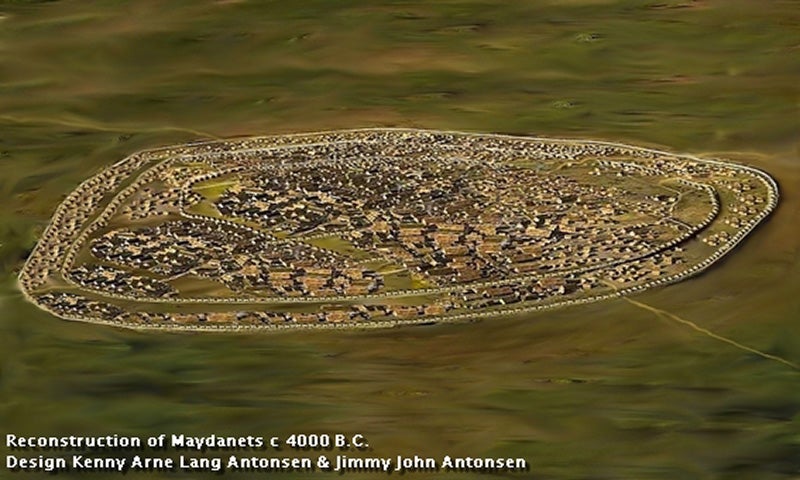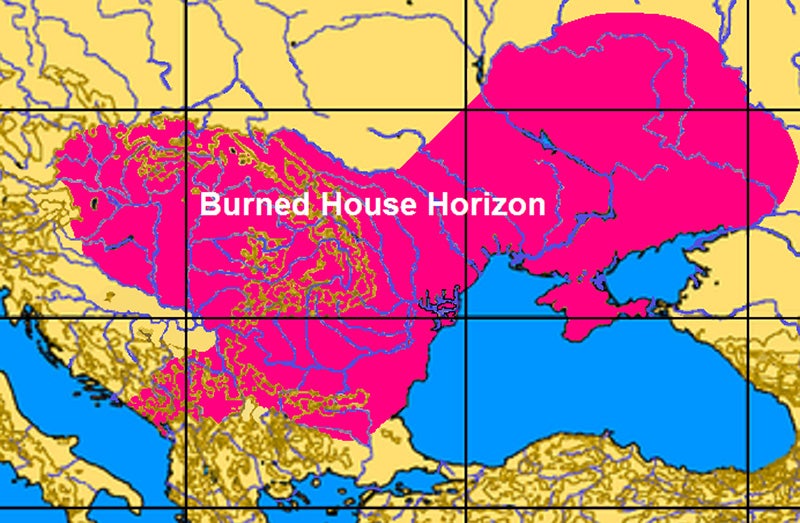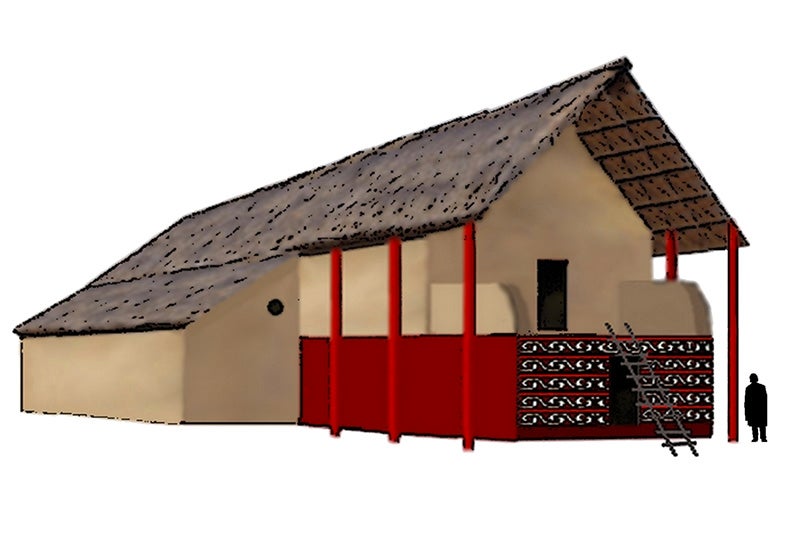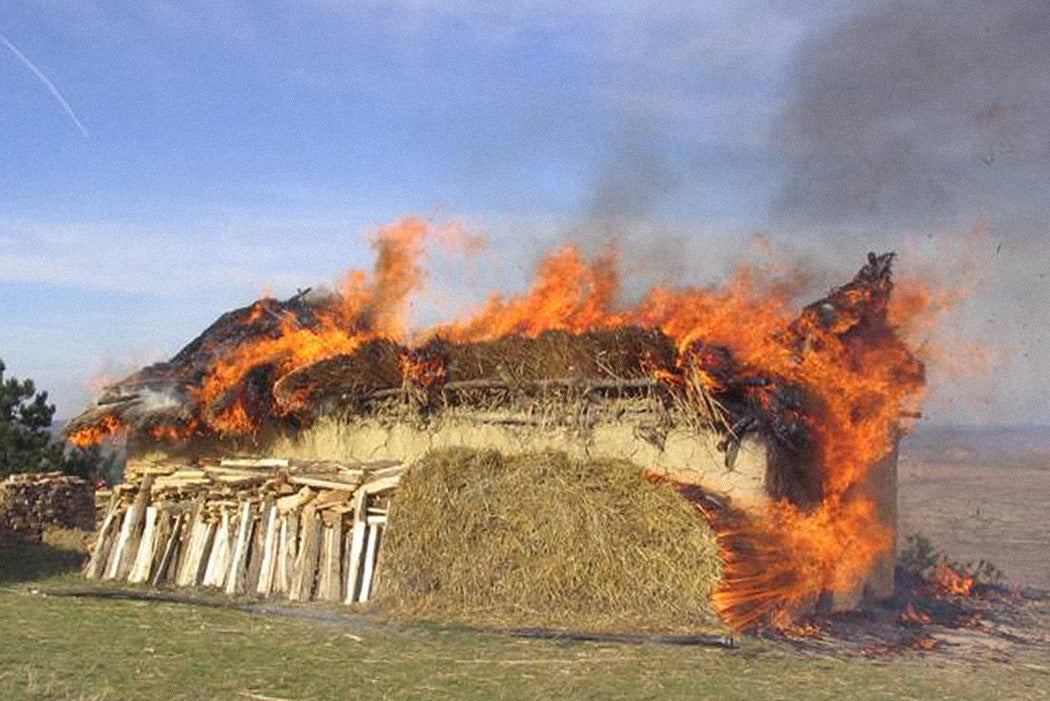Between 5500 and 2750 BC, the present-day countries of Romania, Moldova, and Ukraine were populated by a loosely affiliated group of people known as the Cucuteni-Trypillia culture. Although not nearly as well-known as the Sumerians of neighboring Mesopotamia, the Cucuteni-Trypillia culture is just as significant. They are the oldest-known society in Europe, and may well have been one of the key progenitors of human civilization in general.
Circumscribed between the Carpathian Mountains and Dnieper and Dniester rivers, the Cucuteni-Trypillia culture—named after two excavation sites located in Romania and Ukraine, respectively—was incredibly advanced for their time. They cultivated wheat, barley, and legumes; built large kilns to bake colorful clay pottery and figurines; and wore jewelry made from copper. Also made from copper were their axes, which they used to cut down trees for their impressive architecture. Actually, “impressive” might be an understatement. Reinforcing wooden frameworks with dried clay, the Cucuteni-Trypillia culture was able to construct what would have been some of the largest buildings in the world, with multiple stories and surfaces of up to 7,534 square feet, nearly the size of two entire basketball courts.

Cucuteni-Trypillia buildings have puzzled archeologists for centuries. The reason is not the size of the structures, but their peculiar state of preservation—a state which, upon closer inspection, indicates that the culture’s meticulously planned settlements were repeatedly, mysteriously burned to the ground every 60 to 80 years.
The Burned House Horizon
The Cucuteni-Trypillia are not the only prehistoric culture whose record is written in fire. Houses seem to have burned down so often in neolithic Central and Eastern Europe that there’s an academic name for the phenomenon: the “burned house horizon.” Coined by the British-American archeologist Ruth Tringham, it denotes an area that—in addition to Romania, Moldova, and Ukraine—covers parts of present-day Serbia, Croatia, Bulgaria, and Hungary, home of the Criș, Starčevo, Dudești, and Vinča peoples, to name a few.
More fascinating than the reach of the burned house horizon are its underlying causes. For a long time, the fires were thought to have started by more routine causes: a lightning strike or an enemy attack. It’s a reasonable hypothesis, especially when one considers that most prehistoric homes would have been filled with highly combustible materials such as grains and textiles. On top of that, why would anybody destroy their own property on purpose?
Weekly Newsletter
Playing devil’s advocate, researchers have come up with some surprisingly good reasons. Mirjana Stevanovic, an archeologist from Serbia, has argued that the structures inside the burned house horizon “were destroyed by deliberate burning and most likely for reasons of a symbolic nature.” Her studies harken back to those of Vikentiy Khvoyka, a pioneering scholar of the Trypillia side of the Cucuteni-Trypillia culture who believed houses were burned down when their inhabitants passed away, turning them from dwellings of the living into what he called “homes of the dead.” Tringham, too, was interested in the practice’s possible cultural significance, devoting part of her 1994 article on the subject to the fictional yet plausible narrative of a Vinča woman who, after being married into an abusive family, cannot help but take a perverse pleasure in watching the possessions of her in-laws turn to ashes.

Evgeniy Yuryevich Krichevski, a Russian archaeologist, took a more pragmatic approach. He suggested the prehistoric peoples of Eastern Europe weren’t destroying their structures so much as they were reinforcing them. According to him, the heat of the flames would have hardened the clay walls into a ceramic surface, while the smoke would have fumigated the living space. More recent studies have grown more pragmatic still, proposing that old structures were burned down mainly for the sake of making space for new ones.
Reconstructing the Past
There are a number of ways to test these theories, most of which point back to the excavation sites themselves. In 2022, a team of Hungarian archeologists and conservationists sought to better understand the nature of the burned house horizon by analyzing soil and plant matter recovered from a site near Budapest. Of three burning events known to have occurred at the site, called Százhalombatta-Földvár, two appear to have been started intentionally.
Archeologists Arthur Bankoff and Frederik Winter went in a different direction. In 1977, the pair purchased a dilapidated home from a peasant family in the Lower Morava River Valley in Serbia, then a part of Yugoslavia. Rather than renovating the place, which happened to be made from the same material as the structures of the burned house horizon, the archeologists wanted to see what would happen if they lit it on fire. While the wooden roof was unsurprisingly destroyed, the home’s clay-plastered walls had remained surprisingly intact. This, together with the fact that the experiment required an enormous amount of fuel, suggests that the prehistoric burnings were deliberate rather than accidental.

Bankoff and Winter are not the only researchers who committed arson in the name of science. In 2018, a team of Ukrainian and British archeologists burned down not one but two historically accurate structures. This experiment was a bit different: Instead of acquiring a preexisting home, the test subjects were built from scratch in the style of the Cucuteni-Trypillia culture. Still, the results were nearly identical. The walls of both buildings were left intact, as were various clay pots and figurines the researchers had placed inside them. What’s more, neither fire managed to spread, indicating that the practice was safe and controllable.
Once again, the researchers were amazed by the amount of fuel that prehistoric people must have used to reach the maximum temperatures recorded in the sediment. Specifically, they would have needed over 130 trees’ worth of firewood for each one-story building, and 250 trees for two-story buildings. A settlement of 100 houses would thus have required an astounding 3.8 square miles of forest. This, the researchers feel, not only rules out the possibility that the burned house horizon can be explained primarily by war, wildfires, or other misfortunes, but it also shows that prehistorians should take seriously the logistical feats these ancient cultures were capable of.
Support JSTOR Daily! Join our new membership program on Patreon today.







